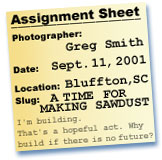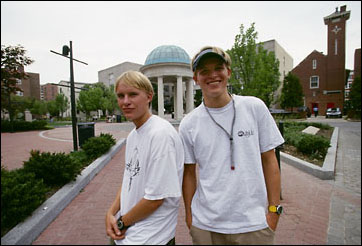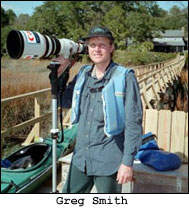 |
|
|
|
|
A Time for Making Sawdust
By Greg Smith
Independent Photographer and Writer
Bluffton, SC
I'm building.
That's a hopeful act. Why build if there is no future?
Well, there is, or at least there seems to be, so we must go on. Some of us will be called on suddenly to chase battles and to document terrorist destruction near home. Some of us may not come back. But statistically, our odds of coming home when we leave in an airplane or car won't be much different than they were on Sept. 10.
As my wife and I realized our twin sons had been in the target zone for at least one of the errant 757s on Sept. 11, she told me she couldn't let her mind dwell there. And, she noted, no place is ever safe. Her father died when his car met the only vehicle -- a hefty oil truck -- for miles around at a lonely crossroad in the middle of a north Oklahoma wheat field.
Things happen. But I'm still building.
Sawdust, swept from the carport, collects in the lawn. Over time, it will rot, building the soil and helping the centipede grass creep over spots left bare by the ravages of insects, clumsy feet and digging dogs.
I hope the new professional sink (something I've always wanted) in my tiny darkroom and the wooden stand/shelf I built to support it will prove useful. I hope I'll be around, healthy enough to develop traditional black-and-white prints in it, with buyers who prompt me to make that effort. But I may not, and they may not be buying.
I'm also, after years of drying prints on an old fiberglass screen stretched across 6-x2-foot frame of 1x2s and propped precariously on a barbell, building a four-level print-drying rack. It will sit nicely in a corner of my loft office, right beside an old file cabinet. I found a nice piece of 3/4-inch, double-finished plywood in the cull bin at Home Depot. It will serve as the top, giving me another place to make piles of important stuff.
And in my sons' bedroom, now abandoned and nearly disinfected since they left in August for a corner dorm room at George Washington University, I have mapped out plans for new storage and a small studio space. A 9-foot piece of countertop, set atop a stack of cinder blocks for 15 years, will finally get base cabinets, with a hole cut to provide a four-foot light table. Wall cabinets above will hold even more stuff. With any luck, my piles will disappear, or at least shrink, and my boys will still have plenty of room to live when they come home.
They're building, too. Dorm regulations at GW won't allow any lofts or other "architectural modifications." But they know well what my wife and I, GW alumni (who have funded most of their scholarships and financial aid), and our community (which has provided $7,000 in additional scholarships for each of them) have invested in their future. They're determined to build themselves into men who will make a difference in the world.
Even if their world almost ended on Sept. 11.

|
||
BLACK TUESDAY
I didn't sleep well that morning. My daughter, a sixth-grader, had left the TV on when she went to school at 7:30. And when I rose 45 sleepless minutes later, I flipped to CNN and left the picture on as I took in my morning fix of NPR, strong coffee and shredded wheat. I glanced up from the day-old newspaper (I'm often too lazy to walk out to the box in the morning) to see a tall building burning. It looked like the World Trade Center, but I figured it was from Singapore, Taipei or maybe Kuala Lumpur. Didn't they build some amazing skyscraper somewhere like that?
I traded sound from radio to TV. How could this happen? My God, what is that? Another plane! Jesus, we're at war! I called my mother next door. I called my wife at work. I called a good friend. I wept. I prayed. Then the Pentagon belched smoke and flame. I called my boys. I woke up their room of six freshmen. Gregory was at class. Michael was asleep, just three blocks from the White House. Their roommate from New Jersey, who answered, said he would turn on the television.
Gregory called me back within minutes. He was OK, still trying to get a handle on what was happening. F-16s were flying low overhead. Helicopters were buzzing. I told him to stay put and avoid strangers with bulges under their coats. That was the last we would speak with them for six tortuous hours. But e-mail came through for us, even if the dispatches were far too infrequent.
I just sat here that day, all alone in my isolated electronic cottage on the river, surfing the news sites, listening to three TVs and NPR. I dialed the boys' number every few minutes. I finally reached their roommate about 3:00. He was grateful I had awakened him that morning. Many neighbors from his hometown worked at the Twin Towers. He was fretful. But my sons weren't there. Despite our warnings, they had set out on foot, past the snipers on the nearby rooftops and across Memorial Bridge to the Pentagon. After much prodding, I had sent Michael a camera and zoom lens the previous week. Just as I certainly would have, he and his brother went out to make pictures, and I suppose, to advance their education.
By 4:00, they had returned. They had seen it. They had photographed it. They had completed another installment in their education. They were in for the night.
And I was out to the river. I paddled my kayak hard against the rising tide, through the marsh and into the edge of a rainstorm. I ducked into what we call "Eagle Cove," near a bald eagle's nest. Sheltered from the driving rain, I unwound just a little. I cried with the sky and prayed. What comes next? Thank God my sons are safe. How many final screams pierced the air that day? May their souls find rest.
The next afternoon, I was staggered when NBC reported Flight 77 had passed the Pentagon from the west, banked over the Capitol and followed Constitution Avenue back toward the White House. It would be hard to set a 757 down between the taller buildings on adjacent blocks. It appeared the hijacker had failed in such an attempt before he banked the plane left over Lafayette Park, crossed the Potomac and crashed into the U.S. military headquarters. Flight 93, the reporter said, may also have been aimed at the White House. Hitting it would have reduced my sons, my hope, to collateral damage.
But the White House survived, unscathed, and so did my sons. Thousands of others did not. And many who read, write for and view The Digital Journalist will be haunted by the sights, sounds and smells of the rubble that entombed 6,000 people.
I've covered several natural disasters, and in each case, I've felt as if my efforts to show and tell what I experienced were woefully inadequate. And as amazing as some of the images and tales that come from our Grounds Zero are, I know they can't convey the full horror of BEING THERE. Yet that very horror draws me. There is a story to tell. I feel compelled to tell it. I want to be there. I thank God I am not.
So instead, I sit here in my electronic cottage, connected to the world, yet alone. I hear cries of war. But I don't hear how that will yield peace. I seek out close friends -- many hundreds of miles away -- whom I know share my worries. I avoid my golfing neighbors who fly flags and talk of revenge. I take heart when I see candlelight vigils bringing very different people together and hear Neil Young sing "Imagine" in a fundraiser for victims. I cringe when I hear the president offend the Muslim world with talk of a "crusade," and when flag-waving idiots call for earth-scorching retaliation. I ponder how spending a few billion dollars on alternative fuels might have headed off the hundreds of billions that war and airline bailouts will cost us -- and the thousands of lives that have and will be lost to a greedy lack of foresight. I know we must strike back, but I fear in doing so, we may become the evil we fight. Winning involves more than making an opponent lose.
I also tune into the tales of colleagues who have visited the hell that used to be south Manhattan. I'm chilled. I'm angry. I grieve for Bill Biggart and other victims. I wish a speedy recovery to David Handschuh and others injured. I'm disappointed to learn of how Mark Phillips has been harassed, because some people see the devil in his image of Tower 1 burning. And I'm disgusted to hear that Jonathan Barth's agency -- Getty's Liaison -- thought that terrible Tuesday was a good evening to stick it to him by demanding a buyout of his images.
LOOKING AHEAD
And that brings me to the subject this month's journal was supposed to touch on: The Future of Photojournalism. We've seen some incredible work from this disaster, much of it featured on other pages here. James Nachtwey got his new agency off to a powerful start with his images of the attack's aftermath. The public clearly saw the power of pictures demonstrated by him and other dedicated folks who have chronicled this disaster. Their video showed us what happened. Their stills helped us absorb its meaning.
But the news media conglomerates, already complaining of weak advertising, just published and aired a tremendous amount of material with NO advertising. One weekly issue with no ads represents, potentially, a 2 percent drop in annual revenues. Three to four days of airtime with no ads could represent a percentage point in annual income for a network. And those figures don't count the increased costs of covering the attack. The publishers and broadcasters aren't likely to be in a generous mood when it comes time to make a deal.
Meantime, we photographers are still squeezed. We've had a slow year, too, and things are expected to get slower. We haven't had raises from our freelance clients in years, yet they demand more rights. Agencies ignore our contracts with them (which for the most part aren't good to begin with) as soon as the going gets tough. We get a chance to show our stuff covering this, and the public has been glued to our coverage, hanging on every word, pondering every image. Yet some people call us vultures. They suggest we give up our income from our pictures, calling it "blood money." They don't suggest the heroic fire and police officers refuse overtime. They don't suggest the long-distance companies return their windfall that resulted from us reaching out to touch our loved ones in troubled times. They budget billions to bolster airlines, pay construction companies and buy the tools of war. And they don't refuse to pay their cable bills.
There's a lot to ponder on these issues, and I'm sure we'll get around to it in coming months. For now, I'm sending off my membership papers to the new Creative Eye co-op for photographers and illustrators, which I've helped to promote and defend. With my commitment and my images, I believe I'm helping to build a better market for us. I've also helped organize a new monthly roundtable for photographers in my area. And I'm hosting the ASMP/South Carolina quarterly meeting this month.
|
Despite those efforts, this (former?) photojournalist hasn't been inspired -- or hired -- to document the local angles on our collective international story. The New York Times National Desk called two days ago. But they never called back after I told the editor on the line that I wouldn't sign away rights to everything I've ever done for them in order to have the chance to feed quotes to a writer. Instead of covering news, I've spent the past two months reading and watching it. I've been packing my boys off to college, photographing and printing family portraits, photographing a large wedding made small in the aftermath of the attack, making custom black-and-white prints from two weddings, photographing the egrets and other wildlife I stalk in my kayak, waiting for a book contract to finally be settled (more next month), purchasing and starting to learn new software, contemplating computer and camera investments, brainstorming ways to create and profit, and... Building. Perhaps rebuilding. That's what I plan soon for my web site (http://imediasmith.com). It's what I need to do right now. It's what the bald eagles down the river are doing with their Volkswagen-sized nest. And I think it's what we all need to do -- even if what we build may get knocked down. |

|
Courage,
Greg Smith
mediasmith@hargray.com
http://imediasmith.com
